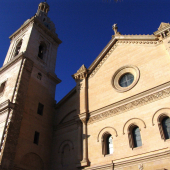THE COLEGIATA
Built to be a cathedral
THE COLEGIATA
Built to be a cathedral
LA SEU
The Collegiate Basilica of Santa María is popularly known as La Seu, although the city has never achieved its ambition to become an episcopal seat. Together with the castle, it is one of Xàtiva’s most emblematic buildings; both stand out against the city skyline and are visible from all points in the surrounding area. It has been declared a Cultural Heritage Site.
Blend of artistic styles
Construction, which commenced in the late 16th century on the site of an earlier mosque, took more than four centuries and even today remains unfinished. This extraordinary delay has given birth to a popular local saying: “this lasts longer than the construction of the Seu”. The plan is a Latin cross, with a very pronounced transept and ambulatory and the style and size of the great Gothic cathedrals. The building evidences a Herrerian influence, marked by an austerity that testifies to its direct relationship with the monastery of El Escorial. The collegiate museum contains a splendid collection of religious art, with outstanding paintings and pieces of Gothic craftsmanship in precious metals.
PORTA DEL MERCAT DOOR
This is the oldest of the Seu doors, and opens onto a neighbourhood formerly known as the market. It forms part of the initial construction commenced in 1568, when San Juan de Ribera placed the first stone and launched the building works. In sober Renaissance style, it overlooks the street of Sant Vicent.
PUERTA DE LOS ESCALONES DOOR
The north façade is embellished by this Baroque door that opens onto the street of Abat Pla. Its upper frontispiece depicts a silhouette of the castle from when it still retained all its towers intact.
BELL TOWER AND MAIN ENTRANCE
The 60-metre high bell tower dates to the 19th century and is crowned by a shrine to the Virgen de la Seo, patron saint of the city, reached after climbing 180 steps. The main entrance to the Seu, which was not completed until the first third of the 20th century, is flanked by bronze statues of Xàtiva’s two popes, Callixtus III and Alexander VI.
HIGH ALTAR
The Mare de Déu de la Seu, the work of Mariano Benlliure, presides over a majestic presbytery. The beautiful rose marble columns are carved from single blocks of stone, excavated from the nearby sierra del Buixcarró hills. The altar is an outstanding piece of work by Ventura Rodríguez, one of the most important architects of Spanish neo-Classicism.
THE MUSEUM
The collegiate museum is entered from the ambulatory and houses the main treasures of the Seu; a superb collection of religious art, including pieces of Gothic painting such as the altarpieces attributed to the Valencian Jacomart, and outstanding examples of precious metalwork related to the liturgy and the Borgia popes.
THE PROCESSIONAL CROSS
One of the most beautiful pieces of Gothic precious metalwork from the times of the ancient Crown of Aragon. Dated to the late 14th century and worked in silver, it contains some thirty pieces of translucent enamelwork.
LA CUSTODIA MAYOR
Made in the 15th century, this piece of precious metalwork is in the flamboyant Gothic style. Each year, on the Feast of Corpus Christi, it is carried through the streets in procession. Local tradition maintains that it was made from the first silver to arrive from America, which the Catholic monarchs gave to Pope Alexander VI, who in turn donated it to the collegiate church.
THE PROCESSIONAL CROSS
One of the most beautiful pieces of Gothic precious metalwork from the times of the ancient Crown of Aragon. Dated to the late 14th century and worked in silver, it contains some thirty pieces of translucent enamelwork.
LA CUSTODIA MAYOR
Made in the 15th century, this piece of precious metalwork is in the flamboyant Gothic style. Each year, on the Feast of Corpus Christi, it is carried through the streets in procession. Local tradition maintains that it was made from the first silver to arrive from America, which the Catholic monarchs gave to Pope Alexander VI, who in turn donated it to the collegiate church.
THE CHALICE OF CALLIXTUS III
This piece of Gothic goldwork was presented to the church by Pope Callixtus III. It has six pictorial medallions on the foot, and many others on the knot and the bowl.
SANTA ANA ALTARPIECE
Also known as the Callixtus III altarpiece, since it was he who commissioned it for the family chapel in the church. Variously attributed to the Valencian painter Jacomart, his disciple Pere Reixac, or both, it is a key piece in Valencian Gothic painting since its incorporation of elements of Renaissance humanism illustrates the transition from the Gothic to the Renaissance style.
THE CHALICE OF CALLIXTUS III
This piece of Gothic goldwork was presented to the church by Pope Callixtus III. It has six pictorial medallions on the foot, and many others on the knot and the bowl.
RETABLO DE SANTA ANA
Also known as the Callixtus III altarpiece, since it was he who commissioned it for the family chapel in the church. Variously attributed to the Valencian painter Jacomart, his disciple Pere Reixac, or both, it is a key piece in Valencian Gothic painting since its incorporation of elements of Renaissance humanism illustrates the transition from the Gothic to the Renaissance style.
INFORMATION
Colegiata Basílica de Santa María
Plaza Calixto III square
Telephone: +34 962281481
http://seudexativa.org/
Museum and bell tower opening times:
From Tuesday to Friday: 10:30 a.m. – 1 p.m.
Saturday and Sunday: 11:30 a.m. – 1 p.m.
Price:
Adults: 3€
Children and groups (minimum of 10 people): 2€
AUDIO GUIDES







